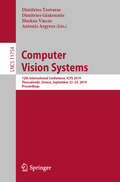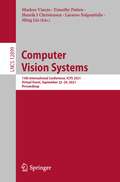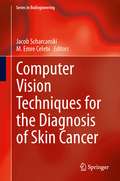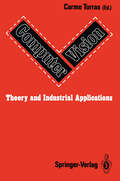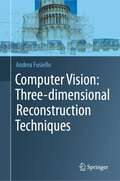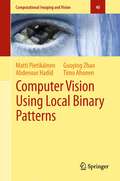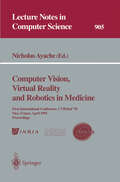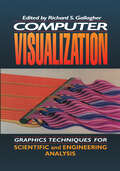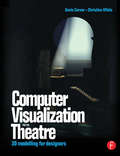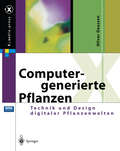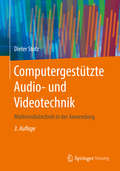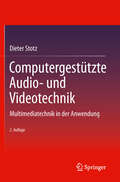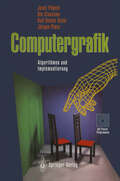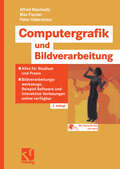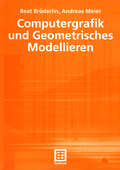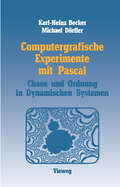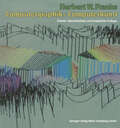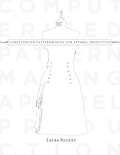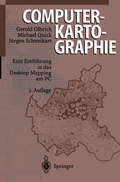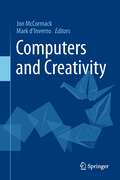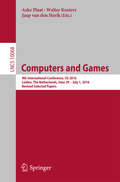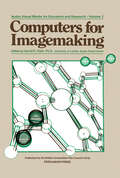- Table View
- List View
Computer Vision Systems: 12th International Conference, ICVS 2019, Thessaloniki, Greece, September 23–25, 2019, Proceedings (Lecture Notes in Computer Science #11754)
by Dimitrios Tzovaras Dimitrios Giakoumis Markus Vincze Antonis ArgyrosThis book constitutes the refereed proceedings of the 12th International Conference on Computer Vision Systems, ICVS 2019, held in Thessaloniki, Greece, in September 2019.The 72 papers presented were carefully reviewed and selected from 114 submissions. The papers are organized in the following topical sections; hardware accelerated and real time vision systems; robotic vision; vision systems applications; high-level and learning vision systems; cognitive vision systems; movement analytics and gesture recognition for human-machine collaboration in industry; cognitive and computer vision assisted systems for energy awareness and behavior analysis; and vision-enabled UAV and counter UAV technologies for surveillance and security of critical infrastructures.
Computer Vision Systems: 13th International Conference, ICVS 2021, Virtual Event, September 22-24, 2021, Proceedings (Lecture Notes in Computer Science #12899)
by Markus Vincze Timothy Patten Henrik I Christensen Lazaros Nalpantidis Ming LiuThis book constitutes the refereed proceedings of the 13th International Conference on Computer Vision Systems, ICVS 2021, held in September 2021. Due to COVID-19 pandemic the conference was held virtually. The 20 papers presented were carefully reviewed and selected from 29 submissions. cover a broad spectrum of issues falling under the wider scope of computer vision in real-world applications, including among others, vision systems for robotics, autonomous vehicles, agriculture and medicine. In this volume, the papers are organized into the sections: attention systems; classification and detection; semantic interpretation; video and motion analysis; computer vision systems in agriculture.
Computer Vision Techniques for the Diagnosis of Skin Cancer (Series in BioEngineering)
by Jacob Scharcanski M. Emre CelebiThe goal of this volume is to summarize the state-of-the-art in the utilization of computer vision techniques in the diagnosis of skin cancer. Malignant melanoma is one of the most rapidly increasing cancers in the world. Early diagnosis is particularly important since melanoma can be cured with a simple excision if detected early. In recent years, dermoscopy has proved valuable in visualizing the morphological structures in pigmented lesions. However, it has also been shown that dermoscopy is difficult to learn and subjective. Newer technologies such as infrared imaging, multispectral imaging, and confocal microscopy, have recently come to the forefront in providing greater diagnostic accuracy. These imaging technologies presented in this book can serve as an adjunct to physicians and provide automated skin cancer screening. Although computerized techniques cannot as yet provide a definitive diagnosis, they can be used to improve biopsy decision-making as well as early melanoma detection, especially for patients with multiple atypical nevi.
Computer Vision: Theory and Industrial Applications
by Carme TorrasThis book is the fruit of a very long and elaborate process. It was conceived as a comprehensive solution to several deficiencies encountered while trying to teach the essentials of Computer Vision in different contexts: to technicians from industry looking for technological solutions to some of their problems, to students in search of a good subject for a PhD thesis, and to researchers in other fields who believe that Computer Vision techniques may help them to analyse their results. The book was carefully planned with all these people in mind. Thus, it covers the fundamentals of both 2D and 3D Computer Vision and their most widespread industrial applications, such as automated inspection, robot guidance and workpiece acquisition. The level of explanation is that of an expanded introductory text, in the sense that, besides the basic material, some special advanced topics are included in each chapter, together with an extensive bibliography for experts to follow up. Well-known researchers on each of the topics were appointed to write a chapter following several guidelines to ensure a consistent presentation throughout. I would like to thank the authors for their patience, because some of them had to go through several revisions of their chapters in order to avoid repetition and to improve the homogeneity and coherence of the book. I hope they will find that the final result has been worth their efforts.
Computer Vision: Three-dimensional Reconstruction Techniques
by Andrea FusielloFrom facial recognition to self-driving cars, the applications of computer vision are vast and ever-expanding. Geometry plays a fundamental role in this discipline, providing the necessary mathematical framework to understand the underlying principles of how we perceive and interpret visual information in the world around us. This text explores the theories and computational techniques used to determine the geometric properties of solid objects through images. It covers the basic concepts and provides the necessary mathematical background for more advanced studies. The book is divided into clear and concise chapters covering a wide range of topics including image formation, camera models, feature detection and 3D reconstruction. Each chapter includes detailed explanations of the theory as well as practical examples to help the reader understand and apply the concepts presented. The book has been written with the intention of being used as a primary resource for students on university courses in computer vision, particularly final year undergraduate or postgraduate computer science or engineering courses. It is also useful for self-study and for those who, outside the academic field, find themselves applying computer vision to solve practical problems. The aim of the book is to strike a balance between the complexity of the theory and its practical applicability in terms of implementation. Rather than providing a comprehensive overview of the current state of the art, it offers a selection of specific methods with enough detail to enable the reader to implement them.
Computer Vision Using Local Binary Patterns (Computational Imaging and Vision #40)
by Matti Pietikäinen Abdenour Hadid Guoying Zhao Timo AhonenThe recent emergence of Local Binary Patterns (LBP) has led to significant progress in applying texture methods to various computer vision problems and applications. The focus of this research has broadened from 2D textures to 3D textures and spatiotemporal (dynamic) textures. Also, where texture was once utilized for applications such as remote sensing, industrial inspection and biomedical image analysis, the introduction of LBP-based approaches have provided outstanding results in problems relating to face and activity analysis, with future scope for face and facial expression recognition, biometrics, visual surveillance and video analysis. Computer Vision Using Local Binary Patterns provides a detailed description of the LBP methods and their variants both in spatial and spatiotemporal domains. This comprehensive reference also provides an excellent overview as to how texture methods can be utilized for solving different kinds of computer vision and image analysis problems. Source codes of the basic LBP algorithms, demonstrations, some databases and a comprehensive LBP bibliography can be found from an accompanying web site. Topics include: local binary patterns and their variants in spatial and spatiotemporal domains, texture classification and segmentation, description of interest regions, applications in image retrieval and 3D recognition - Recognition and segmentation of dynamic textures, background subtraction, recognition of actions, face analysis using still images and image sequences, visual speech recognition and LBP in various applications.Written by pioneers of LBP, this book is an essential resource for researchers, professional engineers and graduate students in computer vision, image analysis and pattern recognition. The book will also be of interest to all those who work with specific applications of machine vision.
Computer Vision, Virtual Reality and Robotics in Medicine: First International Conference, CVRMed '95, Nice, France, April 3 - 6, 1995. Proceedings (Lecture Notes in Computer Science #905)
by Nicholas AyacheThis book contains the written contributions to the program of the First In ternational Conference on Computer Vision, Virtual Reality, and Robotics in Medicine (CVRMed'95) held in Nice during the period April 3-6, 1995. The articles are regrouped into a number of thematic sessions which cover the three major topics of the field: medical image understanding, registration problems in medicine, and therapy planning, simulation and control. The objective of the conference is not only to present the most innovative and promising research work but also to highlight research trends and to foster dialogues and debates among participants. This event was decided after a preliminary successful symposium organized in Stanford in March 1994 by E. Grimson (MIT), T. Kanade (CMU), R. Kikinis and W. Wells (Chair) (both at Harvard Medical School and Brigham and Women's Hospital), and myself (INRIA). We received 92 submitted full papers, and each one was evaluated by at least three members of the Program Committee, with the help of auxiliary reviewers. Based on these evaluations, a representative subset of the Program Committee met to select 19 long papers, 29 regular papers, and 27 posters. The geographical repartition of the contributions is the following: 24 from European countries (other than France), 23 contributions from France, 20 from Northern America (USA and Canada), and 8 from Asia (Japan and Singapore).
Computer Visualization: Graphics Techniques for Engineering and Scientific Analysis
by Richard S. GallagherRapid advances in 3-D scientific visualization have made a major impact on the display of behavior. The use of 3-D has become a key component of both academic research and commercial product development in the field of engineering design. Computer Visualization presents a unified collection of computer graphics techniques for the scientific visualization of behavior. The book combines a basic overview of the fundamentals of computer graphics with a practitioner-oriented review of the latest 3-D graphics display and visualization techniques. Each chapter is written by well-known experts in the field. The first section reviews how computer graphics visualization techniques have evolved to work with digital numerical analysis methods. The fundamentals of computer graphics that apply to the visualization of analysis data are also introduced. The second section presents a detailed discussion of the algorithms and techniques used to visualize behavior in 3-D, as static, interactive, or animated imagery. It discusses the mathematics of engineering data for visualization, as well as providing the current methods used for the display of scalar, vector, and tensor fields. It also examines the more general issues of visualizing a continuum volume field and animating the dimensions of time and motion in a state of behavior. The final section focuses on production visualization capabilities, including the practical computational aspects of visualization such as user interfaces, database architecture, and interaction with a model. The book concludes with an outline of successful practical applications of visualization, and future trends in scientific visualization.
Computer Visualization: Graphics Techniques for Engineering and Scientific Analysis
Rapid advances in 3-D scientific visualization have made a major impact on the display of behavior. The use of 3-D has become a key component of both academic research and commercial product development in the field of engineering design. Computer Visualization presents a unified collection of computer graphics techniques for the scientific visualization of behavior. The book combines a basic overview of the fundamentals of computer graphics with a practitioner-oriented review of the latest 3-D graphics display and visualization techniques. Each chapter is written by well-known experts in the field. The first section reviews how computer graphics visualization techniques have evolved to work with digital numerical analysis methods. The fundamentals of computer graphics that apply to the visualization of analysis data are also introduced. The second section presents a detailed discussion of the algorithms and techniques used to visualize behavior in 3-D, as static, interactive, or animated imagery. It discusses the mathematics of engineering data for visualization, as well as providing the current methods used for the display of scalar, vector, and tensor fields. It also examines the more general issues of visualizing a continuum volume field and animating the dimensions of time and motion in a state of behavior. The final section focuses on production visualization capabilities, including the practical computational aspects of visualization such as user interfaces, database architecture, and interaction with a model. The book concludes with an outline of successful practical applications of visualization, and future trends in scientific visualization.
Computer Visualization for the Theatre: 3D Modelling for Designers
by Gavin Carver Christine WhiteTheatre designers using 3D software for computer visualisation in the theatre will find this book both a guide to the creative design process as well as an introduction to the use of computers in live performance. Covering the main software packages in use: Strata Studio Base, 3D Studio Max and 3D Studio Viz, the book provides techniques for 3D modelling alongside creative ideas and concepts for working in 3D space. Projects are provided to sharpen your awareness and digital skills as well as suggested further reading to broaden the scope of your theatrical and design knowledge. This book is both a useful day to day reference as well as an inspirational starting point for implementing your own ideas. The authors are experienced trainers in the field and understand the pitfalls to be avoided as well as the possibilities to be explored using computer visualisation for designing theatre space. They provide insightful hands on descriptions of techniques used in the development of performance projects set in the wider context of design considerations. The book is highly informative about the technology of computer visualisation providing examples of working practice applicable to all software.
Computer Visualization for the Theatre: 3D Modelling for Designers
by Gavin Carver Christine WhiteTheatre designers using 3D software for computer visualisation in the theatre will find this book both a guide to the creative design process as well as an introduction to the use of computers in live performance. Covering the main software packages in use: Strata Studio Base, 3D Studio Max and 3D Studio Viz, the book provides techniques for 3D modelling alongside creative ideas and concepts for working in 3D space. Projects are provided to sharpen your awareness and digital skills as well as suggested further reading to broaden the scope of your theatrical and design knowledge. This book is both a useful day to day reference as well as an inspirational starting point for implementing your own ideas. The authors are experienced trainers in the field and understand the pitfalls to be avoided as well as the possibilities to be explored using computer visualisation for designing theatre space. They provide insightful hands on descriptions of techniques used in the development of performance projects set in the wider context of design considerations. The book is highly informative about the technology of computer visualisation providing examples of working practice applicable to all software.
Computergenerierte Pflanzen: Technik und Design digitaler Pflanzenwelten (X.media.press)
by Oliver DeussenDie Schönheit der Natur mit dem Rechner nachzubilden, fasziniert die Computergraphik seit jeher. Im vorliegenden Buch werden Verfahren zur Erzeugung künstlicher Pflanzenmodelle beschrieben und deren Anwendung in Bereichen wie Simulation, Virtual Reality, Botanik, Landschaftsplanung und Architektur. Die Modelle werden zu Gärten, Parks und ganzen Landschaften kombiniert. Die Palette der Darstellungsformen reicht von täuschend echt wirkenden Bildern bis zu abstrakten Repräsentationen. Mit ähnlichen Algorithmen können organische Körper hergestellt, verändert und animiert werden. Die beigefügten Programme (Windows) erlauben dies auch dem Leser.
Computergestützte Audio- und Videotechnik: Multimediatechnik in der Anwendung
by Dieter StotzDiese Einführung in die moderne Audio- und Videotechnik ermöglicht Lesern mit technischem Grundverständnis einen leichten Einstieg – auch in komplexe Zusammenhänge. Der Autor vermittelt detailliertes Wissen, praxisnah und verständlich aufbereitet: von den Grundlagen der Ton- und Videotechnik über Abtastung und Digitalisierung, räumliches Hören, Datenkompression, MIDI-Standard und -Signale, digitale Audiomesstechnik bis zu hochauflösender Videotechnik, Genlock, Chromakeying, Schnittsystemen und Animation. Mit vielen Graphiken und Abbildungen.
Computergestützte Audio- und Videotechnik: Multimediatechnik in der Anwendung
by Dieter StotzDiese Einführung in die moderne Audio- und Videotechnik ermöglicht Lesern mit technischem Grundverständnis einen leichten Einstieg – auch in komplexe Zusammenhänge. Der Autor vermittelt detailliertes Wissen, praxisnah und verständlich aufbereitet: von den Grundlagen der Ton- und Videotechnik über Abtastung und Digitalisierung, räumliches Hören, Datenkompression, MIDI-Standard und -Signale, digitale Audiomesstechnik bis zu hochauflösender Videotechnik, Genlock, Chromakeying, Schnittsystemen und Animation. Mit vielen Graphiken und Abbildungen.
Computergrafik: Algorithmen und Implementierung
by Josef Pöpsel Ute Claussen Rolf-Dieter Klein Jürgen PlateComputergrafik befaßt sich mit den Grundlagen der zwei- und dreidimensionsalen Computergrafik und deren Anwendung in PC-basierten Systemen. Neben der Darstellung mathematischer Grundlagen, einfacher Techniken und fortgeschrittener Bilderzeugungsalgorithmen steht die Umsetzung und Anwendung im Vordergrund. Radiosity-, Ray-Tracing- und andere Darstellungsverfahren können mit der beiliegenden Software in einer breit verfügbaren Systemumgebung ausprobiert werden. Leserinnen und Leser haben somit die Möglichkeit, die Methoden durch spielerischen Umgang mit der Software zu erlernen, sie für eigene Projekte zu nutzen oder sogar zu erweitern. Alle Programme sind im Pascal-Quelltext verfügbar.
Computergrafik und Bildverarbeitung: Alles für Studium und Praxis - Bildverarbeitungswerkzeuge, Beispiel-Software und interaktive Vorlesungen online verfügbar
by Alfred Nischwitz Max Fischer Peter HaberäckerVorteile dieses Buches sind der klare didaktische Aufbau und die - nahezu - vollständige Behandlung aktueller Methoden und Themen. Von der Generierung synthetischer Bilder und Szenarien in interaktiven Anwendungen über die Vorverarbeitung und Merkmalsextraktion digitaler Bilder bis zur Bildsegmentierung, Objekterkennung und Objektverfolgung mit Kalman-Filtern. Folgende Themen wurden in der zweiten Auflage ergänzt: Der Canny-Kantendetektor und die Segmentierung lauflängenkodierter Binärbilder mit einem Union-Find-Algorithmus. "Das Werk ist eine anspruchsvolle, aber verständlich geschriebene und didaktisch gut gemachte Darstellung der beiden Bereiche [Computergrafik und Bildbearbeitung]." ekz-Informationsdienst, ID 18/07
Computergrafik und Geometrisches Modellieren (XLeitfäden der Informatik)
by Beat Brüderlin Andreas MeierGrundlagen der Computergrafik und des Geometrischen Modellierens werden mit diesem Buch dargestellt. Es behandelt neuere rasterbasierte Techniken (z.B. Texturmapping und Anti-Aliasing), die in modernen Grafikbibliotheken und Grafikkarten von PCs üblich sind. Daneben werden Ray-Tracing und Radiosity Methoden und objektraum-definierte Modelliertechniken, sowie effiziente Algorithmen der Geometrie grundlegend besprochen. Zu den einzelnen Kapiteln sind Übungsaufgaben angeführt.
Computergrafik - Zur Geschichte und Produktionsästhetik synthetischer Bilder (Image #230)
by Carolin SchelerEs existieren zahlreiche Verfahren, um digitale Bilder zu erzeugen. Diese Vielfalt erschwert es allerdings, digitale Fotografien, KI- oder CGI-Bilder voneinander zu differenzieren. Carolin Scheler legt am Beispiel der 3D-Computergrafik einen grundlegend neuen Ansatz vor, digitale Bilderzeugnisse ästhetisch zu analysieren. Ausgehend vom Produktionsprozess beschreibt sie die Computergrafik als eigenständiges Ausdrucksverfahren und arbeitet eine den computergenerierten Bildern inhärente ideologische Vorstellung von Realismus heraus. Es wird deutlich: In der computergrafischen Softwareentwicklung ist immer ein bestimmtes Weltgefühl eingeschrieben - mit Auswirkungen auf das Verhältnis von Bild und Wirklichkeit.
Computergrafische Experimente mit Pascal: Ordnung und Chaos in Dynamischen Systemen
by Karl-Heinz Becker Michael DörflerComputerized Patternmaking for Apparel Production
by Laura NugentComputerized Patternmaking for Apparel Production takes a unique approach to learning Gerber AccuMark technology. This book includes all the procedures that the fashion industry uses to create a style and rush it to a factory for cutting and mass production. Through 20 lessons focusing on patternmaking, digitizing, grading, and marker making, students will grasp the cycle of apparel production from patternmaking to cutting. This book bridges the gap between knowing what the software functions do and applying them in today's working environment.
Computerkartographie: Eine Einführung in das Desktop Mapping am PC
by Gerold Olbrich Michael Quick Jürgen SchweikartDie Darstellung raumbezogener Daten in Kartenform hat dank der rasanten Entwicklung entsprechender Software stark zugenommen. Immer häufiger bedienen sich heute auch Praktiker und Wissenschaftler, die im Zuge ihrer Ausbildung keine Erfahrung auf dem Gebiet der thematischen Kartographie sammeln konnten, dieser Form der Visualisierung. Ziel dieses Titels ist es daher, dem Leser zunächst unverzichtbares Basiswissen aus dem Bereich der thematischen Kartographie zu vermitteln, um darauf aufbauend die Methodik der angewandten Computerkartographie zu erläutern. Darüber hinaus wird ein Überblick über die Leistungsmerkmale gängiger Software gegeben. Die beiliegende CD-ROM enthält Demoversionen zu den verschiedenen Programmen. Ein Quellenverzeichnis im Anhang führt Bezugsadressen für Koordinatendaten und Software auf.
Computers and Creativity
by Jon McCormack and Mark d’InvernoThis interdisciplinary volume introduces new theories and ideas on creativity from the perspectives of science and art. Featuring contributions from leading researchers, theorists and artists working in artificial intelligence, generative art, creative computing, music composition, and cybernetics, the book examines the relationship between computation and creativity from both analytic and practical perspectives. Each contributor describes innovative new ways creativity can be understood through, and inspired by, computers.The book tackles critical philosophical questions and discusses the major issues raised by computational creativity, including: whether a computer can exhibit creativity independently of its creator; what kinds of creativity are possible in light of our knowledge from computational simulation, artificial intelligence, evolutionary theory and information theory; and whether we can begin to automate the evaluation of aesthetics and creativity in silico. These important, often controversial questions are contextualised by current thinking in computational creative arts practice. Leading artistic practitioners discuss their approaches to working creatively with computational systems in a diverse array of media, including music, sound art, visual art, and interactivity.The volume also includes a comprehensive review of computational aesthetic evaluation and judgement research, alongside discussion and insights from pioneering artists working with computation as a creative medium over the last fifty years. A distinguishing feature of this volume is that it explains and grounds new theoretical ideas on creativity through practical applications and creative practice.Computers and Creativity will appeal to theorists, researchers in artificial intelligence, generative and evolutionary computing, practicing artists and musicians, students and any reader generally interested in understanding how computers can impact upon creativity. It bridges concepts from computer science, psychology, neuroscience, visual art, music and philosophy in an accessible way, illustrating how computers are fundamentally changing what we can imagine and create, and how we might shape the creativity of the future.Computers and Creativity will appeal to theorists, researchers in artificial intelligence, generative and evolutionary computing, practicing artists and musicians, students and any reader generally interested in understanding how computers can impact upon creativity. It bridges concepts from computer science, psychology, neuroscience, visual art, music and philosophy in an accessible way, illustrating how computers are fundamentally changing what we can imagine and create, and how we might shape the creativity of the future.
Computers and Games: 9th International Conference, CG 2016, Leiden, The Netherlands, June 29 – July 1, 2016, Revised Selected Papers (Lecture Notes in Computer Science #10068)
by Aske Plaat Walter Kosters Jaap HerikThis book constitutes the thoroughly refereed post-conference proceedings of the 9th International Conference on Computers and Games, CG 2016, held in Leiden, The Netherlands,in conjunction with the 19th Computer Olympiad and the 22nd World Computer-Chess Championship.The 20 papers presented were carefully reviewed and selected of 30 submitted papers. The 20 papers cover a wide range of computer games and many different research topics in four main classes which determined the order of publication: Monte Carlo Tree Search (MCTS) and its enhancements (seven papers), concrete games (seven papers), theoretical aspects and complexity (five papers) and cognition model (one paper). The paper Using Partial Tablebases in Breakthrough by Andrew Isaac and Richard Lorentz received the Best Paper Award.
Computers for Imagemaking
by D. ClarkComputers for Image-Making tells the computer non-expert all he needs to know about Computer Animation. In the hands of expert computer engineers, computer picture-drawing systems have, since the earliest days of computing, produced interesting and useful images. As a result of major technological developments since then, it no longer requires the expert's skill to draw pictures; anyone can do it, provided they know how to use the appropriate machinery. This collection of specially commissioned articles reflects the diversity of user applications in this expanding field
